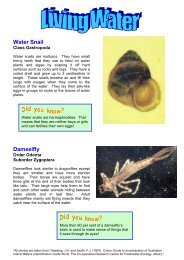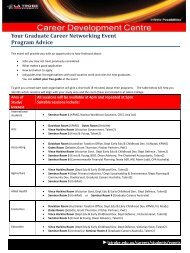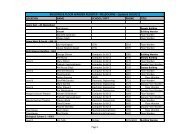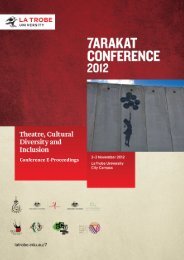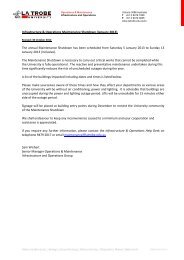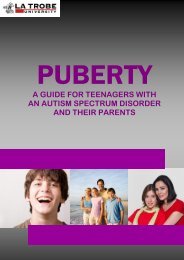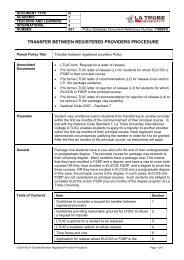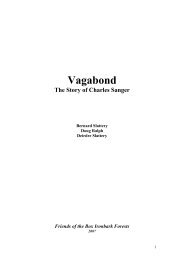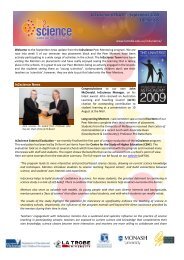Project Report - La Trobe University
Project Report - La Trobe University
Project Report - La Trobe University
Create successful ePaper yourself
Turn your PDF publications into a flip-book with our unique Google optimized e-Paper software.
Publishing for a wider audience?<br />
All the materials we produced were intended<br />
solely for the use and enjoyment of the Ichananaw.<br />
But given the number of requests for copies of the<br />
educational materials – the storybooks especially –<br />
from people and organizations outside Chananaw,<br />
both in Australia and the Philippines, we have<br />
begun to investigate the possibility of reproducing<br />
the books for a wider audience. First, we are<br />
making arrangements with the Ichananaw, Ang<br />
Ilustrador ng Kabataan, Ateneo Center for<br />
Educational Development and Art Angel Printshop<br />
so as to be able to simply reproduce the books noncommercially,<br />
but we are also thinking about the<br />
option of publishing the books commercially so as<br />
to allow the books to reach a wider audience. We<br />
would only facilitate a commercial arrangement if<br />
it maintained the integrity of all involved, and only<br />
with the full approval of everyone concerned.<br />
A co-authored ethnography<br />
We plan to co-author an ethnographic account of<br />
the Ichananaw’s way of life, over the coming years,<br />
with certain members of the tribe – Apalis (Ombin)<br />
Abaggoy in particular. In addition, the<br />
ethnographic account will examine how practices<br />
and beliefs are changing over time and how they<br />
vary across the geographically-spread Ichananaw<br />
communities (specifically, comparing the upland<br />
community in Chananaw with the lowland<br />
Ichananaws living in <strong>La</strong>cnog and Ipil, Tabuk).<br />
Writing will be conducted in both the Philippines<br />
and Australia, with communication via the<br />
internet.<br />
Ethnobotanical documentation<br />
Australian botanist David Cameron (Maria’s father)<br />
came to the Philippines in May 2009 to visit<br />
Chananaw, at our invitation. This allowed David,<br />
quite unexpectedly, to initiate an ethnobotanical<br />
investigation of the flora and vegetation of the<br />
Ichananaw’s ancestral domain. David hopes to<br />
develop this project further over coming years. It is<br />
envisaged that extended periods of plant<br />
identification in Australia alternate with short,<br />
intensive field trips to Chananaw. The ultimate<br />
objective is to document the Ichananaw’s<br />
indigenous plant lore and changing relationship<br />
with their environment, against the backdrop of a<br />
taxonomically rigorous documentation of the rich<br />
and vanishing flora of the Ichananaw’s ancestral<br />
domain. This should also furnish educational<br />
Indigenizing Education in a Kalinga Public School | 27<br />
One of our many adventures during the visit by<br />
Maria’s father David Cameron to Chananaw in May<br />
2009 was a hike to the primary rainforest on the<br />
Ichananaw’s ancestral domain. From left to right:<br />
Tollangao Onalan, Gaspar Dawing, David Cameron and<br />
Apalis (Ombin) Abaggoy. After a delicious lunch, we<br />
drank coffee from cups Tollangao fashioned deftly<br />
from bamboo with his machete (David holds a cup in<br />
his hand), before continuing on to check if any animals<br />
had been caught in the fitu traps (large, stone-lined<br />
pits dug into the ground and camouflaged with leaves<br />
and twigs, for catching wild pigs or deer).



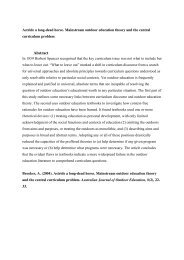
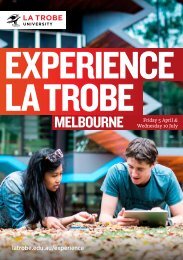
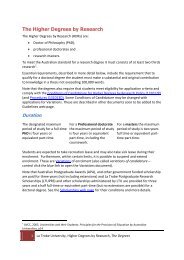
![Ottoman Empire course brochure [PDF 612KB] - La Trobe University](https://img.yumpu.com/12001562/1/184x260/ottoman-empire-course-brochure-pdf-612kb-la-trobe-university.jpg?quality=85)
![Getting Ready to Talk Manual [PDF 315KB] - La Trobe University](https://img.yumpu.com/11430807/1/190x245/getting-ready-to-talk-manual-pdf-315kb-la-trobe-university.jpg?quality=85)
